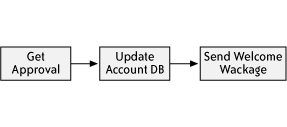Name
Basic Patterns
Synopsis
Basic patterns cover fundamental process capabilities: running activities in a sequence; spawning, and later joining, parallel lines of execution; and branching into one of several directions based on a conditional choice. The five basic P4 patterns are: Sequence, Parallel Split, Synchronization, Exclusive Choice, and Simple Merge.
Sequence
The intent of the Sequence pattern is to run activities sequentially. For example, run activity A followed by B followed by C, and so on. This pattern is also known as Sequence Flow.
The need for activity sequencing is obvious: almost every process has at least one segment of two or more steps to be performed sequentially. In Figure 4-1, for example, the process of opening a bank account requires getting a manager to approve the account open application, updating the account database, and sending a welcome package to the customer.
 |
Given that activity sequencing is an essential part of the
notion of process, it is not surprising that all BPM vendors and
specifications support the Sequence pattern. In BPEL, for example,
the implementation of the bank account process uses the sequence activity:
<sequence>
<invoke name="Get approval" . . . />
<invoke name="Update account DB" . . . />
<invoke name="Send welcome package" . . ./>
</sequence>This pattern is related ...
Get Essential Business Process Modeling now with the O’Reilly learning platform.
O’Reilly members experience books, live events, courses curated by job role, and more from O’Reilly and nearly 200 top publishers.

